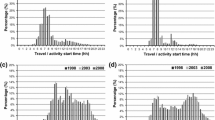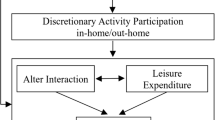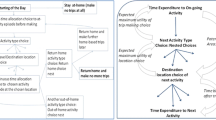Abstract
This paper presents a detailed analysis of discretionary leisure activity engagement by children. Children’s leisure activity engagement is of much interest to transportation professionals from an activity-based travel demand modeling perspective, to child development professionals from a sociological perspective, and to health professionals from an active lifestyle perspective that can help prevent obesity and other medical ailments from an early age. Using data from the 2002 Child Development Supplement of the Panel Study of Income Dynamics, this paper presents a detailed analysis of children’s discretionary activity engagement by day of week (weekend versus weekday), location (in-home versus out-of-home), type of activity (physically active versus passive), and nature of activity (structured versus unstructured). A mixed multiple discrete-continuous extreme value model formulation is adopted to account for the fact that children may participate in multiple activities and allocate positive time duration to each of the activities chosen. It is found that children participate at the highest rate and for the longest duration in passive unstructured leisure activities inside the home. Children in households with parents who are employed, higher income, or higher education were found to participate in structured outdoor activities at higher rates. The child activity modeling framework and methodology presented in this paper lends itself for incorporation into larger activity-based travel model systems where it is imperative that children’s activity-travel patterns be explicitly modeled—both from a child health and well-being policy perspective and from a travel forecasting perspective.
Similar content being viewed by others
Notes
The reader will note that we adopt the “child-centric” approach in the current paper. That is, in analyzing children’s activity-travel patterns, children are chosen as the units of analysis and treated as decision makers. This approach recognizes that children as young as 6–8 years start developing their own identities, taste preferences, and social needs (see Stefan and Hunt 2006; CDC 2005; Eccles 1999). They then interact with their parents and other adults to facilitate these needs.
MDCEV is a theoretically appealing, conceptually intuitive, and relatively simple structure for time allocation analysis. This is not a standard RUM-based discrete choice model like the multinomial logit or nested logit. In these standard models, only one alternative can be chosen and there is no continuous element. On the other hand, in the RUM-based MDCEV model, multiple alternatives can be chosen for consumption, and there is a continuous component of consumption.
The term “outside good” refers to a good that is “outside” the purview of the choice of whether to be consumed or not. That is, the “outside good” is a good that is always consumed by all consumers. Within this modeling framework, the in-home, unstructured, passive activities that are pursued by all children on weekdays and weekend days are considered “outside” alternatives, while all other activities (where participation rates are less than 100%) are referred to as “inside” alternatives.
Several other utility function forms were also considered, but the one presented provided the best data fit in the empirical analysis of the current paper. For conciseness, these alternative forms are not discussed. The reader is referred to Bhat (2008) for a detailed discussion of alternative utility forms.
In the context of this paper, satiation effects are defined as the diminishing marginal returns from the invested time in a discretionary activity category as the time invested in that activity category increases. Satiation effects are based on the aggregate time consumption in a particular activity on the designated day. That is, satiation effects are incorporated at the day-level rather than at the individual episode-level.
It should be noted that a few statistically insignificant variables were retained in the final models as they were considered important to understand the relative impacts of explanatory factors on children’s leisure activity patterns.
References
Bhat, C.R.: Simulation estimation of mixed discrete choice models using randomized and scrambled Halton Sequences. Transp. Res. B 37(9), 837–855 (2003)
Bhat, C.R.: A multiple discrete-continuous extreme value model: formulation, application to discretionary time-use decisions. Transp. Res. B 39(8), 679–707 (2005)
Bhat, C.R.: The multiple discrete-continuous extreme value (MDCEV) model: role of utility function parameters, identification considerations, and model extensions. Transp. Res. B 42(3), 274–303 (2008)
Bhat, C.R., Gossen, R.: A mixed multinomial logit model analysis of weekend recreational episode type choice. Transp. Res. B 38(9), 767–787 (2004)
Carnegie Corporation of New York.: A matter of time: risk and opportunity in the non-school hours. Carnegie Corporation of New York, New York (1992)
Center for Disease Control (CDC).: Youth risk behavior surveillance—United States, 2001. Morbidity and Mortality Weekly Report Surveillance Summaries, 51(SS-4) (2002)
Center for Disease Control (CDC).: Physical activity levels among children aged 9–13 years—United States, 2002. Morb. Mortal. Wkly. Rep. 52(33), 785–788 (2003)
Center for Disease Control (CDC).: Positive parenting tips for healthy child development. Child Development (2005). Online at http://www.cdc.gov/ncbddd/child/documents/6-8YearOldsPositiveParenting.pdf
Center for Disease Control (CDC).: Youth risk behavior surveillance—United States, 2005. Morb. Mortal. Wkly. Rep. 55(SS-5) (2006)
Clifton, K.J.: Independent mobility among teenagers: an exploration of travel to after-school activities. Transp. Res. Rec. 1854, 74–80 (2003)
Cole-Hamilton, I., Harrop, A., Street, C.: The value of children’s play and play provision: a systematic review of the literature. New Policy Institute. Available at: http://www.sportdevelopment.org.uk/playliterature2002.pdf (2002). Accessed 28 January 2008
Copperman, R.B., Bhat, C.R.: An analysis of the determinants of children’s weekend physical activity participation. Transportation 34(1), 67–87 (2007a)
Copperman, R.B., Bhat, C.R.: An exploratory analysis of children’s daily time-use and activity patterns using the child development supplement (CDS) to the US panel study of income dynamics (PSID). Transp. Res. Rec. 2021, 36–44 (2007b)
Darling, N.: Participation in extracurricular activities and adolescent adjustment: cross-sectional and longitudinal findings. J. Youth Adolesc. 34(5), 493–505 (2005)
Eccles, J.S.: The development of children ages 6 to 14. The Future of Children 9(2), 30–44 (1999)
Frusti, T., Bhat, C.R., Axhausen, K.W.: An exploratory analysis of fixed commitments in individual activity-travel patterns. Transp. Res. Rec. 1807, 101–108 (2003)
Hofferth, S., Brayfield, A., Diech, S., Holcomb, P.: The national child care survey 1990. The Urban Press, Washington, DC (1991)
Hofferth, S.L., Jankuniene, J.: Life after school. Association for supervision and curriculum development, 19–23 (2001)
Huebner, A.J., Mancini, J.A.: Shaping structured out-of-school time use among youth: the effects of self, family, and friend systems. J. Youth Adolesc. 32(6), 453–463 (2003)
Koolstra, C.M., van der Voort, T.H.A.: Longitudinal effects of television on children’s leisure-time reading: a test of three explanatory models. Human Commun. Res. 23(1), 4–35 (1996)
Krizek, K., Birnbaum, A., Levinson, D.: A schematic for focusing on youth in investigation of community design and physical activity. Am. J. Health Promot. 19(1), 33–38 (2004)
Mackett, R.L., Lucas, L., Paskins, J., Turbin, J.: The therapeutic value of children’s everyday travel. Transp. Res. A 39, 205–219 (2005)
Mahoney, J.L., Stattin, H.: Leisure activities and adolescent antisocial behavior: the role of structure and social context. J. Adolesc. 23, 113–117 (2000)
McDonald, N.: An exploratory analysis of children’s travel patterns. Transp. Res. Rec. 1997, 1–7 (2006)
McMillan, T.E.: The relative influence of urban form on a child’s travel mode to school. Transp. Res. A 41, 69–79 (2007)
Osgood, D.W., Wilson, J.K., O’Malley, P.M., Bachman, J.G., Johnson, L.D.: Routine activities and individual deviant behavior. Am. Sociol. Rev. 61, 635–655 (1996)
Posner, J.K., Vandell, D.L.: Low-income children’s after-school care: are there beneficial effects of after-school programs? Child Dev 65(2); Child. Poverty, 440–456 (1994)
Posner, J.K., Vandell, D.L.: After-school activities and the development of low-income urban children: A longitudinal study. Dev. Psychol. 35(3), 868–879 (1997)
Reisner, E.: Understanding family travel demands as a critical component in work-family research, transportation and land-use. Presented at From 9 to 5 to 24/7: How Workplace Changes Impact Families, Work and Communities, Academic Work and Family Research Conference, March 2003
Ross, J.G., Dotson, C.O., Gilbert, G.G., Katz, S.J.: After physical education—physical activity outside of school physical education programs. J. Phys. Educ. Recreation Dance 56, 35–39 (1985)
Sallis, J.F., Prochaska, J.J., Taylor, W.C.: A review of correlates of physical activity of children and adolescents. Med. Sci. Sports Exerc. 32(5), 963–975 (2000)
Sener, I.N., Bhat, C.R.: An analysis of the social context of children’s weekend discretionary activity participation. Transportation 34(6), 697–721 (2007)
Shann, M.H.: Students’ use of time outside of school: a case for after-school programs for urban middle school youth. Urban Rev 33(4), 339–355 (2001)
Stefan, K.J., Hunt, J.D.: Age-based analysis of children in Calgary, Canada. Presented at the 85th Annual Meeting of the Transportation Research Board, Washington, DC, January 2006
Timmer, S.G., Eccles, J., O’Brien, K.: How children use time. In: Juster, F.T., Stafford, F.P. (eds) Time, Goods, and Well-being, pp. 353–381. University of Michigan, Institute for Social Research, Ann Arbor, (1985)
Transportation Research Board and Institute of Medicine.: Does the built environment influence physical activity? Examining the evidence. TRB Special Report 282, National Research Council, Washington, DC, 2005
United States Department of Health and Human Services (USDHHS).: Healthy people 2010: understanding and improving health, 2nd edn. U.S. Government Printing Office, Washington, DC, November 2000
Acknowledgements
The authors thank the anonymous reviewers for useful comments that greatly enhanced the paper. The authors are responsible for any errors and omissions.
Author information
Authors and Affiliations
Corresponding author
Rights and permissions
About this article
Cite this article
Sener, I.N., Copperman, R.B., Pendyala, R.M. et al. An analysis of children’s leisure activity engagement: examining the day of week, location, physical activity level, and fixity dimensions. Transportation 35, 673–696 (2008). https://doi.org/10.1007/s11116-008-9173-9
Published:
Issue Date:
DOI: https://doi.org/10.1007/s11116-008-9173-9




